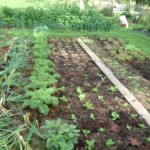 Many homesteaders love to grow using organic methods. They appreciate the quality of the food, and are sensitive to what they are putting in the ground.
Many homesteaders love to grow using organic methods. They appreciate the quality of the food, and are sensitive to what they are putting in the ground.
We’ve been shocked to find that there are homesteaders who still have a tendency to stay away from organic gardening due to the fact that they’re afraid that bugs and disease will afflict their crops. Likely, they are just not fully informed. Or, they have listened to too many clever advertisements from fertilizer companies.
Get a Free Monthly Digital Subscription to PREPARE Magazine
The fact is, you just do not require those added chemical elements and fertilizers to make your yard grow dynamic and safely. Take a few minutes to read these organic gardening pointers and find out exactly how to grow plants naturally.
Here are some practical and basic Organic Gardening Tips to Grow Healthier and Better-Tasting food:
- When watering your garden consider using a soaker-hose rather of utilizing a typical garden hose or watering can. If you turn the soaker hoses pressure onto reduced, you can leave your water on for hours which will permit a part of your garden to be slowly irrigated. This can give you with time to do other things.
- When you are digging holes in your backyard where to plant bushes, bushes, or trees, do not make it perfect. Holes with ideal sides will in fact work against you by limiting plant development. The roots can not permeate the sheer face made by a shovel.
- If you are experiencing a problem with slugs or various other insects, a fantastic organic contact pesticide is diatomaceous earth. You can buy this at most yard centers, and it is available in a white powder form. It is an abrasive material that will eliminate the critters by harming the skin of the slugs and joints of the insects.
- A great way to calculate the timing for growing your plants in an organic garden is to use a seed-starting chart and graph. You need to do your research and fill in the plan in advance. When you have it, you can make use of the chart to envisioning your growing with the whole period.
- Make certain you plant heirloom plants and seeds. Heirloom plants produce feasible seed – seed that will produce a plant of the exact same qualities and attributes as the moms and dad plant. The majority of seed that you get today from industrial sources is hybrid seed. That means that the seeds will not produce naturally. Therefore, it is not encouraged that you save them from year to year.
- To help spread mulch more easily, you can use a flat-head rake or a bow. If you are using a rake, you ought to make use of the rakes tined edge to draw and spread your mulch. Use the flat side of the rake to even your mulch on the bed. You will want to utilize a light push then pull action.
- When growing an organic garden, be careful when dealing with insects. You desire to make use of the least-harmful pollutant-free items. Try numerous methods such as physical removal, different kinds of barriers, or even traps. If those fail, attempt biological controls. If that fails, attempt organic or mineral-based pesticides.
- To keep rodents, deer, and various other troublesome animals far from your organic yard, make use of organic repellents. A spray made from hot peppers can be efficient. Otherwise attempt a spray consisting of urine or rotten eggs. Regardless of exactly what you make use of, use the sprays liberally and reapply frequently particularly after a rain shower.
Now as you can plainly see from the ideas and tips above, you will not need those added chemical and unnatural elements to assist in growing any kind of plant – whether it’s a flower or a tomato. All you need is the right knowledge to ensure that your plants are getting exactly what they should grow strong and healthy.


